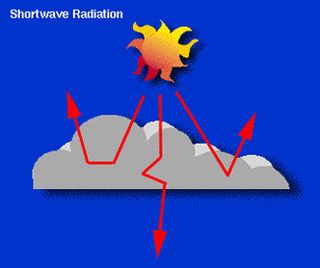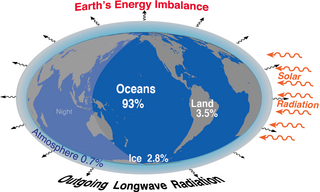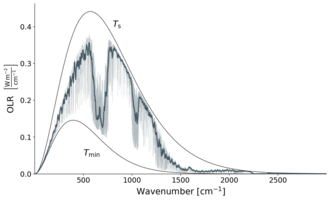
The greenhouse effect occurs when greenhouse gases in a planet's atmosphere trap some of the heat radiated from the planet's surface, raising its temperature. This process happens because stars emit shortwave radiation that passes through greenhouse gases, but planets emit longwave radiation that is partly absorbed by greenhouse gases. That difference reduces the rate at which a planet can cool off in response to being warmed by its host star. Adding to greenhouse gases further reduces the rate a planet emits radiation to space, raising its average surface temperature.

Global warming potential (GWP) is an index to measure of how much infrared thermal radiation a greenhouse gas would absorb over a given time frame after it has been added to the atmosphere. The GWP makes different greenhouse gases comparable with regards to their "effectiveness in causing radiative forcing". It is expressed as a multiple of the radiation that would be absorbed by the same mass of added carbon dioxide, which is taken as a reference gas. Therefore, the GWP is one for CO2. For other gases it depends on how strongly the gas absorbs infrared thermal radiation, how quickly the gas leaves the atmosphere, and the time frame being considered.

Numerical climate models use quantitative methods to simulate the interactions of the important drivers of climate, including atmosphere, oceans, land surface and ice. They are used for a variety of purposes from study of the dynamics of the climate system to projections of future climate. Climate models may also be qualitative models and also narratives, largely descriptive, of possible futures.

In meteorology, cloud forcing, cloud radiative forcing (CRF) or cloud radiative effect (CRE) is the difference between the radiation budget components for average cloud conditions and cloud-free conditions. Much of the interest in cloud forcing relates to its role as a feedback process in the present period of global warming.

Thermal radiation is electromagnetic radiation generated by the thermal motion of particles in matter. Thermal radiation is generated when heat from the movement of charges in the material is converted to electromagnetic radiation. All matter with a temperature greater than absolute zero emits thermal radiation. At room temperature, most of the emission is in the infrared (IR) spectrum. Particle motion results in charge-acceleration or dipole oscillation which produces electromagnetic radiation.

A microwave radiometer (MWR) is a radiometer that measures energy emitted at one millimeter-to-metre wavelengths (frequencies of 0.3–300 GHz) known as microwaves. Microwave radiometers are very sensitive receivers designed to measure thermally-emitted electromagnetic radiation. They are usually equipped with multiple receiving channels to derive the characteristic emission spectrum of planetary atmospheres, surfaces or extraterrestrial objects. Microwave radiometers are utilized in a variety of environmental and engineering applications, including remote sensing, weather forecasting, climate monitoring, radio astronomy and radio propagation studies.

Radiative forcing is the change in energy flux in the atmosphere caused by natural or anthropogenic factors of climate change as measured in watts per meter squared. It is a scientific concept used to quantify and compare the external drivers of change to Earth's energy balance. These external drivers are distinguished from climate feedbacks and internal variability, which also influence the direction and magnitude of imbalance.
This glossary of climate change is a list of definitions of terms and concepts relevant to climate change, global warming, and related topics.

The emissivity of the surface of a material is its effectiveness in emitting energy as thermal radiation. Thermal radiation is electromagnetic radiation that most commonly includes both visible radiation (light) and infrared radiation, which is not visible to human eyes. A portion of the thermal radiation from very hot objects is easily visible to the eye.

Earth's energy budget accounts for the balance between the energy that Earth receives from the Sun and the energy the Earth loses back into outer space. Smaller energy sources, such as Earth's internal heat, are taken into consideration, but make a tiny contribution compared to solar energy. The energy budget also accounts for how energy moves through the climate system. Because the Sun heats the equatorial tropics more than the polar regions, received solar irradiance is unevenly distributed. As the energy seeks equilibrium across the planet, it drives interactions in Earth's climate system, i.e., Earth's water, ice, atmosphere, rocky crust, and all living things. The result is Earth's climate.
The effective temperature of a body such as a star or planet is the temperature of a black body that would emit the same total amount of electromagnetic radiation. Effective temperature is often used as an estimate of a body's surface temperature when the body's emissivity curve is not known.

The infrared atmospheric window refers to a region of the infrared spectrum where there is relatively little absorption of terrestrial thermal radiation by atmospheric gases. The window plays an important role in the atmospheric greenhouse effect by maintaining the balance between incoming solar radiation and outgoing IR to space. In the Earth's atmosphere this window is roughly the region between 8 and 14 μm although it can be narrowed or closed at times and places of high humidity because of the strong absorption in the water vapor continuum or because of blocking by clouds. It covers a substantial part of the spectrum from surface thermal emission which starts at roughly 5 μm. Principally it is a large gap in the absorption spectrum of water vapor. Carbon dioxide plays an important role in setting the boundary at the long wavelength end. Ozone partly blocks transmission in the middle of the window.
A runaway greenhouse effect occurs when a planet's atmosphere contains greenhouse gas in an amount sufficient to block thermal radiation from leaving the planet, preventing the planet from cooling and from having liquid water on its surface. A runaway version of the greenhouse effect can be defined by a limit on a planet's outgoing longwave radiation which is asymptotically reached due to higher surface temperatures evaporating water into the atmosphere, increasing its optical depth. This positive feedback means the planet cannot cool down through longwave radiation and continues to heat up until it can radiate outside of the absorption bands of the water vapour.
The anti-greenhouse effect is a process that occurs when energy from a celestial object's sun is absorbed or scattered by the object's upper atmosphere, preventing that energy from reaching the surface, which results in surface cooling – the opposite of the greenhouse effect. In an ideal case where the upper atmosphere absorbs all sunlight and is nearly transparent to infrared (heat) energy from the surface, the surface temperature would be reduced by 16%, which is a significant amount of cooling.

An atmospheric window is a region of the electromagnetic spectrum that can pass through the atmosphere of Earth. The optical, infrared and radio windows comprise the three main atmospheric windows. The windows provide direct channels for Earth's surface to receive electromagnetic energy from the Sun, and for thermal radiation from the surface to leave to space. Atmospheric windows are useful for astronomy, remote sensing, telecommunications and other science and technology applications.

The temperatures of a planet's surface and atmosphere are governed by a delicate balancing of their energy flows. The idealized greenhouse model is based on the fact that certain gases in the Earth's atmosphere, including carbon dioxide and water vapour, are transparent to the high-frequency solar radiation, but are much more opaque to the lower frequency infrared radiation leaving Earth's surface. Thus heat is easily let in, but is partially trapped by these gases as it tries to leave. Rather than get hotter and hotter, Kirchhoff's law of thermal radiation says that the gases of the atmosphere also have to re-emit the infrared energy that they absorb, and they do so, also at long infrared wavelengths, both upwards into space as well as downwards back towards the Earth's surface. In the long-term, the planet's thermal inertia is surmounted and a new thermal equilibrium is reached when all energy arriving on the planet is leaving again at the same rate. In this steady-state model, the greenhouse gases cause the surface of the planet to be warmer than it would be without them, in order for a balanced amount of heat energy to finally be radiated out into space from the top of the atmosphere.

Greenhouse gases are the gases in the atmosphere that raise the surface temperature of planets such as the Earth. What distinguishes them from other gases is that they absorb the wavelengths of radiation that a planet emits, resulting in the greenhouse effect. The Earth is warmed by sunlight, causing its surface to radiate heat, which is then mostly absorbed by water vapor (H2O), carbon dioxide (CO2), methane (CH4), nitrous oxide (N2O), and ozone (O3). Without greenhouse gases, the average temperature of Earth's surface would be about −18 °C (0 °F), rather than the present average of 15 °C (59 °F).
The planetary equilibrium temperature is a theoretical temperature that a planet would be if it was in radiative equilibrium, typically under the assumption that it radiates as a black body being heated only by its parent star. In this model, the presence or absence of an atmosphere is irrelevant, as the equilibrium temperature is calculated purely from a balance with incident stellar energy.

Water vapor windows are wavelengths of infrared light that have little absorption by water vapor in Earth's atmosphere. Because of this weak absorption, these wavelengths are allowed to reach the Earth's surface barring effects from other atmospheric components. This process is highly impacted by greenhouse gases because of the effective emission temperature. The water vapor continuum and greenhouse gases are significantly linked due to water vapor's benefits on climate change.
In the study of heat transfer, Schwarzschild's equation is used to calculate radiative transfer through a medium in local thermodynamic equilibrium that both absorbs and emits radiation.
























